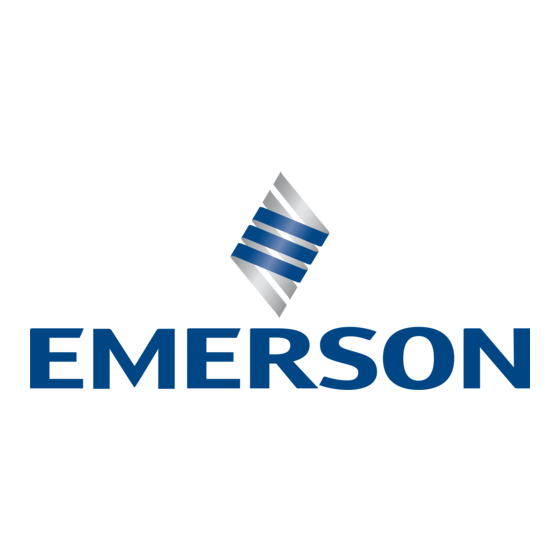Table of Contents

Subscribe to Our Youtube Channel
Summary of Contents for Emerson Copeland Scroll Series
- Page 1 Horizontal Scroll compressors for Horizontal Scroll compressors for Refrigeration Refrigeration...
-
Page 2: Table Of Contents
Contents Introduction ................................3 Nomenclature .................................3 Qualified Refrigerants.............................3 Lubrication ................................4 Liquid Injection................................4 Refrigerant Migration ..............................7 Crankcase Heaters..............................7 Discharge Temperature Protection ........................7 Standard Motor Protection............................7 Mufflers ...................................7 Low Ambient cut-out...............................7 Pressure Controls..............................8 Internal Pressure Relief Valve ..........................8 Pump Down ................................8 Shut-Off ..................................8 Starting ...................................8 Deep Vacuum Operation ............................8 Electrical Installation...............................8... -
Page 3: Introduction
Introduction The Copeland Scroll compressor – using the compliance principle - has been under development at Copeland since 1979 and is the most efficient and durable compressor Copeland has ever developed for air-conditioning, refrigeration and heat pump applications. It offers very low vibration and sound levels and is tolerant to stresses caused by liquid slugging, flooded starts, and debris commonly found in refrigeration systems. -
Page 4: Lubrication
The application envelopes for each refrigerant are shown in section 31 and Copeland Selection software. Lubrication The oil level should be maintained at mid-point of the sight glass. If an oil regulator is being used the level should be set within the top half of the sight glass. An internal positive displaced oil pump, draws oil from the compressor base via a dip tube for lubrication of the bearings. - Page 5 The Copeland DTC valve is equipped with a custom bulb profile, which must be installed in the thermal well of the top cap of the compressor, sensing the temperature closest to the discharge port. The DTC valve injects only when cooling is needed and in the required amounts.
- Page 6 Before Assembly After 2 DTC Valve Assembly Liquid Inlet 4 Thermo Cap Side 3 DTC Bulb View 1 Coil Spring Discharge Oil Sight Suction Stub Glass Stub Check Assembly Coil spring 5 Copper Tube Figure 2: DTC valve assembly procedure Legend to Fig.2: Verify coil spring is seated in the ‘Groove’...
-
Page 7: Refrigerant Migration
Refrigerant Migration Due to the Scroll’s inherentability to handle liquid refrigerant in flooded start and defrost cycle operation, an accumulator may not be required. For single compressor systems with extremely large charges greater than 4,5 kg, an accumulator is recommended. Excessive liquid refrigerant flood- back during normal off cycles, defrost cycles, or steady operation can dilute the oil in any compressor causing inadequate lubrication and bearing wear. -
Page 8: Pressure Controls
12 Pressure Controls Both high and low pressure controls are required and the following working pressures are recommended: For ZFH models, the normal minimum setting should be 0.3 bar (R404A) Maximum is 21 bar. For ZSH and ZBH models operating without liquid injection, the LP cut out should be set as high as possible, normal minimum 0.6 bar. -
Page 9: Three Phase Models
19 Three Phase Models Scroll Models compressors, like several other types of compressors, will only compress in one rotational direction. Direction of rotation is not an issue with single-phase compressors since they will always start and run in the proper direction. However, three- phase compressors will rotate in either direction depending upon phasing of the power to L1, L2 and L3. -
Page 10: High Potential Testing
With service gauges connected to suction and discharge pressure fittings, turn on the compressor. If the suction pressure falls below normal levels the system is either low on charge or there is a flow blockage in the system. Single Phase compressors If suction pressure does not drop and discharge pressure does not rise to normal levels, either the reversing valve or the compressor is faulty. -
Page 11: Shut-Off Valves And Adapters
25 Shut-off Valves and Adapters Horizontal refrigeration scroll compressors are delivered either with brazed connections or threads for Rotalock shut off valves. Brazed pipework can also fit compressors with Rotalock connections using adapters “A” and “B” in either straight or angled “C”. (See fig. 7 and spare parts list ZFH/ZSH and ZBH) Delivery Scope In Operation Mounting... -
Page 12: Unbrazing System Components
These valves could also be used to measure the operating pressures to ensure there are no excessive pressure drops in the suction line and liquid line, which will also give an indication that the expansion device receives full bore liquid, ensuring the system performs at its most efficiently. Evacuating the system only on the suction side of a Scroll compressor can occasionally result in a temporary no-start condition for the compressor. -
Page 13: Suction Line Noise And Vibration
30 Suction Line Noise and Vibration Copeland Scroll compressors inherently have low sound and vibration characteristics. However, in some respects, the sound and vibration characteristics differ from reciprocating compressors and, in rare instances, could result in unexpected sound complaints with plain air-conditioning systems. One difference is that the vibration characteristic of the Scroll compressor, although low, includes two very close frequencies, one of which is normally isolated from the shell by the suspension of an internally suspended compressor. -
Page 14: Application Envelopes
31 Application Envelopes Note: All application envelopes are for 25°C Suction Gas Return conditions unless otherwise stated. R404A/R507 ZFH 06 to ZFH 18 ZSH 21K4 to ZSH 45K4 Te °C Te °C R407C (Mid) ZBH 30-45KCE Mid Point R407C 10K Suction Superheat C6.2.7/0302-0903/E...






Need help?
Do you have a question about the Copeland Scroll Series and is the answer not in the manual?
Questions and answers